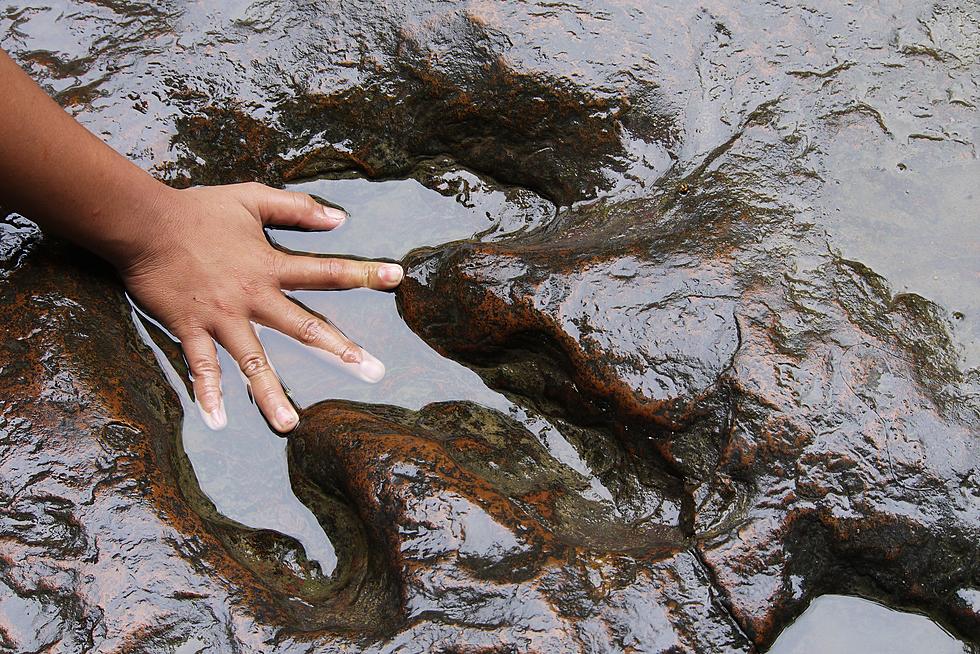
I Was Today Years Old When I Learned Dinosaurs Stomped Around Missouri
I'll admit, I've never thought about dinosaurs roaming around the area where I live. So when I saw the article that a new dinosaur species have been found in Missouri I thought, "There were dinosaurs in Missouri?"
A New Species of Dinosaur Discovered in Missouri
Four States Homepage reports that scientists have discovered a new dinosaur species here in Missouri. The juvenile skeleton of the dinosaur, Parrosaurus Missouriensis, was discovered somewhere in the state by Paleontologist Guy Darrough. They're not disclosing the location to keep down on lookie-loos and other folks until the site can be secured. The TV station also says it's a new genospecies the researchers have never encountered before.
“I can’t imagine anything that’s more impressive than what we discovered here. A new genus in species. Its world-famous discovery” said Darrough to Four States Homepage.
According to their report, it's a duck-billed dinosaur and is about 25 -30 feet long and hasn't been discovered anywhere else. Although, to me, it sounds similar to the dinosaur already discovered in Missouri.
Dinosaur Fossils Are Rarely Found in Missouri
The Missouri Secretary of State's page says dinosaur fossils are rarely discovered in Missouri. In fact, they were discovered only one other time. In 1942, the Chronister family near Glen Allen discovered them while they were digging for a new well.
According to the story on the Secretary of State's page, The Missouri Geological Survey and Water Resources department sent geologist Dan R. Stewart to investigate. He found, "Twelve vertebrae and a few bone fragments belonging to a previously undiscovered species of dinosaur."
He got Dr. C.W. Gilmore of the U.S. Geological Survey involved and they published a paper in 1945 announcing their find. Gilmore classified the dinosaur they had discovered as "Upper Cretaceous sauropod. Sauropods are the largest dinosaurs and include favorites such as Brachiosaurus, Brontosaurus, and Apatosaurus. Gilmore named the Missouri specimen Neosaurus missouriensis."
As science advanced the Missouri dinosaur's scientific name and classification has changed. The Secretary of State website says, "Over time, Missouri’s only dinosaur was reclassified as a hadrosaur, or “duck-billed dinosaur.” Its scientific name was changed to Parrosaurus missouriensis in late 1945, then Hypsibema missouriensis in 1979. Chase Brownstein reverted it back to Parrosaurus in 2018.
Why Is the Secretary of State Talking about Dinosaur Fossils?
It's quite obvious, really. We have a state dinosaur. I was today years old when I learned that too. On August 28, 2004, according to the Statutes of Missouri, "The Hypsibema missouriensis dinosaur is hereby selected for and shall be known as, the official dinosaur of the state of Missouri. (L. 2004 H.B. 1209)."
The discovery of that dinosaur, and probably the dinosaur recently found, is important to paleontologists because it's one of the few species discovered that lived on the east coast of the inland sea that broke up what is today's United States into eastern and western continents.
Dinosaurs in Missouri. Pretty cool if you ask me.
LOOK: Stunning vintage photos capture the beauty of America's national parks
RANKED: Here are the most popular national parks
More From AM 1050 KSIS










